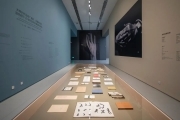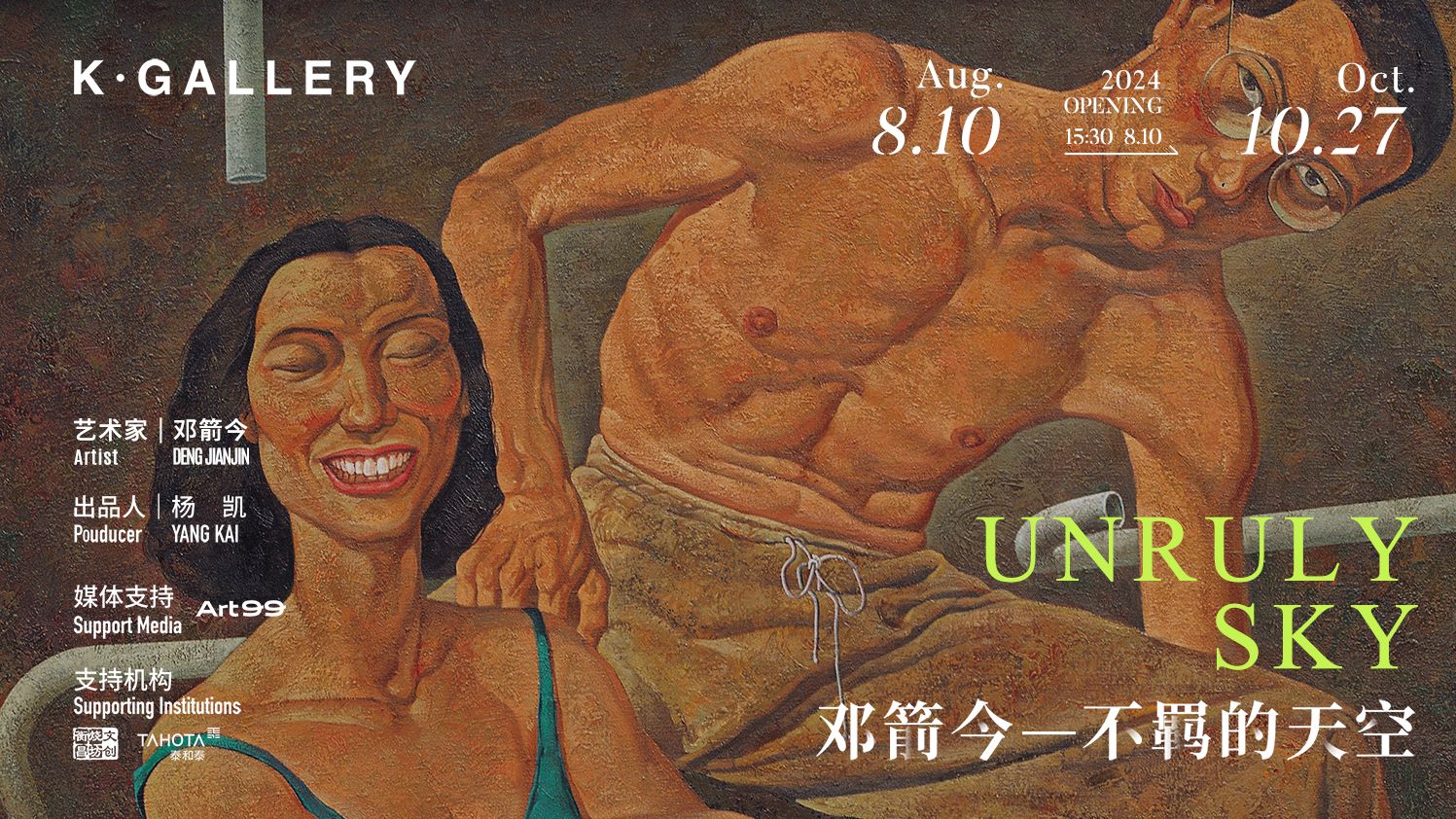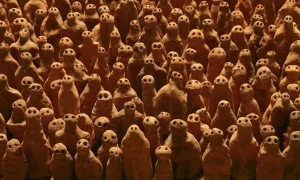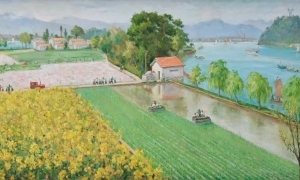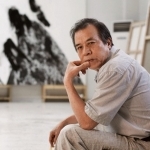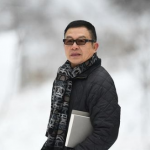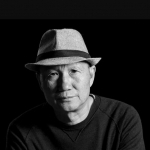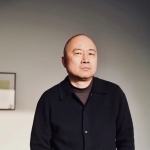每次旅程从飞机的窗口往外望,看着延绵无尽的云海,心中总是有份宁静平和的感觉,这份安逸随着云朵形状的变化,以至不断延伸,容易让我跌入胡思乱想的空间,眼前的蓝天白云,时而幻化成一只巨兽的剪影,不消片刻,随着视野的移动而变成一副慈祥的面孔,这种转眼即逝、无穷无尽不断变化的形象,是视觉上难得的愉快经历,更多的时候,看着看着便入了梦乡,从真实的浮光掠影掉入梦中更广阔的思想世界。这种感受,在日常生活中难以接触到,而看百强的绘画,能让我顷刻找到这份熟悉的感觉,那份没始没终,似断未断的感觉特别令我着迷 。
要怎样形容百强(fortes Sequeira )?他是澳门历史和文化下制造出来的中西融合“产物”,亦即我们说的“土生仔”(中葡混血儿),他们大多会说中、葡双语,但不一定懂得同时看或写其中一方语言,他们很多会有个传统、颇长的葡文名字,那百强是否姓“百”?查明原来他姓“施(Sequeira)”,只是政府相关发证部门胡里胡涂将他的姓氏拿掉,自此他的身份证上只有一个像艺名一样的名字:百强。主要还是因为历史原因与时代的问题,百强与很多土生仔一样,都曾尝试过反叛的坏孩子生活,家庭的影响亦曾让他有过自暴自弃的时候,幸而浪子回头,进入设计的大学课程,让他体内早已潜藏的创作基因得以重新复活,百强的创作范畴甚广,是年青摇滚乐队“刃记”的主音歌手,从他在台上痛快淋漓的表演,很难想象他在台下如何能那么冷静与挥洒自如地绘画创作。
这次“翻墙——百强现场绘画展”是北京全艺社自零八年底开幕至今,举办的首个艺术家个人作品展,也是首个驻场艺术家计划的展览,全艺社一直期望透过北京的平台,鼓励澳门的艺术家前往北京进行创作与交流,并将澳门优秀的艺术作品带到北京与广大市民和艺文界朋友分享。
百强善于用简单的线条绘画在平滑的表面上,没有预先整体的构图,而主题内容多与器官、植物、鬼怪与难以名状的形体所组成,线条图案在画面上无限延伸,有点像生长在墙上的植物蔓藤,总不知道终点在哪里。而从今年开始,百强将这种创作风格发展成现场创作,受全艺社之邀,本年四月于“艺术北京2010——国际艺术博览会”中进行为期五天的现场绘画,过程中吸引不少媒体关注,更有参观者多次到访观看进度。这种现场绘画的形式具表演性质,与书画界雅集即席挥毫有点相似,但却更具观赏性,不是艺术家之间“露两手”的即兴交流,而是有目的地公开本应在工作室内闭门完成的创作,艺术家现场绘画的过程中,无可避免地会被外界影响,而这种充满未知之数的“互动”却往往能产生出人意表的结果。
除了艺术北京,本年五月及六月百强更应澳门文化局邀请,先后于深圳的第六届文博会及厦门的第三届文博会中的“澳门创意馆”进行现场绘画。以上三组作品均会于这次展览中展出,除此以外,十二幅铅笔绘画“小作”亦会同时展出,这批“小作”像是从大型作品中剪裁出来的局部画面,有点像中国白描的感觉,而画作主题却千奇百怪、趣味盎然。而百强于北京驻场期间创作作品“翻墙”,更具意识地冲破平面的框架,在一个木制的房间上,百强用他的绘画语言去翻越他内心的墙壁。“翻墙”一词是内地的网络用语,此“潮语”亦代表了“不走寻常路”的意思,而百强的“翻墙”,跟他的绘画一样,有冲破樊篱、延伸到墙外的意思,亦同时展现出一种顽强的生命力。一个房间,带出“墙内”与“墙外”的关系,“墙外”渴望“翻墙”到“墙内”,可“墙内”其实只是一个窄小的空间,让大家沉迷在内…而反过来看,可看成是政治的现实局面,从地区到国家到世界到宇宙,哪里是“内”?哪里是“外”?
百强于北京驻场创作的某天,电邮跟我说:“晚上的北京这边特别静,静得就连自己的呼吸声一呼一吸也清楚听见,这使我忆起很多儿时回忆,在我三岁多时我外婆经常会带我到她干姊姊家过夜,干婆婆家在澳门陆军俱乐部附近,屋子大得要命,夜晚特别静,静得可怕,在我记忆里面好像没一次能入梦乡,就要辛苦婆婆把我带回家!”未知是北京的宁静让百强穿越时光隧道回到过去,抑或是他的思绪在有意无意之间引领他寻回生活中纯朴愉快的童年?这些脑海中一瞬即逝的画面与印象,似曾相识,说不清那一瞬的感觉是在睡梦中经历过,还是在飞机上半梦半醒的流离状态里,或是在上一次观看百强作画的过程中…
朱焯信
策展人
Every time I look out of the window of the plane while travelling, I inevitably find my mind immersed in perfect tranquillity and peace at the sight of countless seas of cloud stretching to infinity. This sense of ease continues with the changing shape of clouds, leading me into wide flights of fancy. The blue sky and white cloud before my eyes sometimes transform into the silhouette of a huge monster but in a short while it becomes an amiable face. These transient and ever-changing images bring me a memorably pleasant visual experience. Many times I find myself unconsciously falling into a boundless dream world awash with the transient lights and shadows of reality. Such experiences are rare in our daily lives but the paintings by Pakeong bring me a moment of familiarity – an off-and-on feeling without end or beginning – which deeply impresses me.
How should I describe Pakeong? He is a ‘product’ of Chinese and Western integration from Macao’s history and culture, often referred to as so-called ‘Macanese’ (Chinese-Portuguese mixed race). Most Macanese can speak the Chinese and Portuguese languages but they do not really know how to read or write both languages. Conventionally, they have a long Portuguese name. Obviously, Pakeong’s family name is not ‘Pak’ or ‘Fortes’. His real family name is ‘Sequeira’ or ‘Si’, which was accidentally removed by the relevant identification card issuing authority. Since then, the pseudonym-like name of Fortes appears on his identification card.
Like many other young Macanese, Pakeong was a wilful and reckless child due to historical reasons and the influence of the times. Family issues made him lose much confidence and give up on what he was doing. Fortunately, he soon realised that he was being led astray so he attended a design course at university, which inspired him to unleash the creative genes hidden in his body. Pakeong’s works involve a wide variety of genres. As the lead singer of local teenage rock band BladeMark, Pakeong is a fully dedicated artist who greatly enjoys performing on stage. It is difficult to imagine how he can calmly and freely compose paintings off-stage.
Since the opening of AFA Beijing in late 2008, the exhibition Off the Wall – Live Painting by Pakeong is the first solo art exhibition and artist-in-residency show held at the Centre. Via the platform of Beijing, AFA has sought to encourage Macao artists to go to Beijing to create works and exchange ideas, with a view to introducing Macao’s outstanding art works to Beijing and sharing them with the residents and arts circles of the city.
Pakeong excels at drawing simple lines on smooth surfaces without making a sketch, themed largely around organs, plants, ghosts and monsters plus other indescribable shapes and objects. The painting lines, extending to infinity, are like vines without end growing on a wall. This year, Pakeong has developed this style into live painting. In April, he was invited by AFA to conduct a live five-day painting at the ‘Art Beijing 2010’ Contemporary Art Fair and received wide acclaim from the media, attracting audiences to revisit and update themselves on his progress. The form of live painting which entails performing nature is similar to the concept of improvised composition in calligraphy and painting circles but possesses higher visual value. Rather than a form of impromptu exchanges between artists, it is intended to unveil the process of composition that is usually accomplished inside a studio. During the process of live painting, the artist is inevitably influenced by foreign factors; however, such an unexpected ‘interaction’ is often attributable to an unusual work.
In addition to Art Beijing, Pakeong was also invited by the Cultural Affairs Bureau of the MSAR to conduct live painting at the 6th China (Shenzhen) International Cultural Industries Fair and the 3rd Cross-strait (Xiamen) Cultural Industry Fair in May and June this year. Apart from the three work series mentioned above, the forthcoming exhibition features twelve small pencil drawings, which seem like the partial painting of a large-scale work resembling the baimiao (ink outline) technique of Chinese painting. These drawings feature all sorts of strange and interesting themes.
While composing his Off the Wall artist-in-residence project in Beijing, he consciously broke the limitations of plain space and scaled his dwelling wall through his painting language in a wooden room. ‘Off the Wall’ (‘Fanqiang’ or ‘scaling the wall’) is an internet slang used in Mainland China. This slang also has the meaning of ‘not following the usual path’. Similar to his painting, the ‘Off the Wall’ by Pekeong seeks to break barriers and extend to the wall outside while demonstrating vigorous vitality. The room - which reflects the relationship between the ‘inside’ and the ‘outside’ of the wall - denotes that people outside the wall yearn for ‘off the wall’ experiences and getting into the inside of the wall. The inside of the wall is in fact a narrow space, which hooks people; on the contrary, it can be viewed as a political status in reality, from a region to a county, and from the world to the universe, but where is the ‘inside’ and where is the ‘outside’?
One day in Beijing, while creating his live painting, Pakeong sent me an email reading, “The Beijing night is particularly silent and I can clearly hear the sounds of my breath, which brings back childhood memories – when I was three, my grandma would bring me to her sworn sister’s home to stay overnight. The house, which was located near the Macao Military Club, was very large and especially silent at night. The silence frightened me and in my memory not even once could I fall asleep, and my grandma could do nothing but take me home”.
Is it the tranquillity of Beijing that makes Pakeong revisit his past through a time tunnel or do his thoughts consciously or unconsciously lead him to revisit his primitive and pleasant childhood? Such transient mental images and impressions are familiar moments of experience which can hardly be explained, perhaps happening in a dream, in the borderland between sleeping and waking, or during the last time I saw Pakeong create his painting.
Curator
James Chu
【编辑:霍春常】








